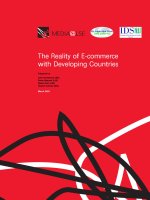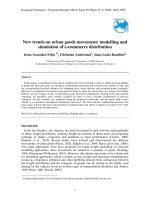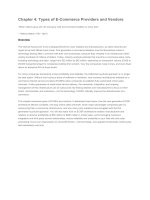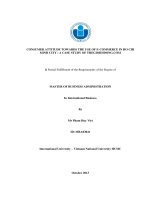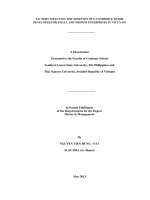Factors of customer shopping behavior via advantages of e commerce graduation paper, major business english
Bạn đang xem bản rút gọn của tài liệu. Xem và tải ngay bản đầy đủ của tài liệu tại đây (474.74 KB, 50 trang )
Full name: VÕ ĐÔNG TUYẾT VY
Student’s code: 15DH710106
Email address:
Phone number: 0368287234
Subject: Graduation Thesis
Date submitted: 18/06/2019
Word count: 8804
Võ Đông Tuyết Vy
DECLARATION
I certify that the attached material is my original work. No other person’s work
or ideas has been used without acknowledgement. Except where I have clearly stated
that I have used some of this material elsewhere, I have not presented this for
assessment in another course or unit at this or any other institution.
Date: 18/06/ 2019
Writer’s Signature and Full name
Võ Đông Tuyết Vy
Võ Đông Tuyết Vy
ABBREVIATIONS LIST
Activities, Interests and Opinions ................................. AIO
American Marketing Association ............................... AMA
Automatic Transaction Machine ................................. ATM
Cash On Delivery ........................................................ COD
Gross Domestic Product .............................................. GDP
Personal Computer ......................................................... PC
Quick Response Code........................................... QR Code
Vietnam Dong .............................................................VND
Vietnam E-Commerce Association ........................ VECOM
Võ Đông Tuyết Vy
ABSTRACT
Online shopping is becoming popular in the modern society because the
conveniences, which bring to people, make their shopping behavior changed. Through
the research, we would like to understand about the marketing, e-commerce, and its
characteristics that could affect the customers more. The study introduced how
customers shopping behavior changed and what advantages of the e-commerce could
do that clearly. Moreover, we also introduced some inconveniences when customer use
the e-commerce for their shopping. In order to get all information above, we would
take the survey for people who live in Ho Chi Minh City and summarize the data to
give the final conclusion for the study. Through the result of the research, we hope that
we could know the most important elements could change the shopping behavior, and
the most difficult things that customers faced to prepare the good solutions to deal with
it. Based on it, the e-commercial companies could apply for their own business, and
help it develop more and more in the future.
Key words: E-commerce, Customers shopping behavior, Advantages, Inconveniences.
Võ Đông Tuyết Vy
LIST OF GRAPHS
GRAPH 4.1. Percentages of people taking the survey in Ho Chi Minh City ...... page 17
TABLE 4.1. Survey takers’ jobs in Ho Chi Minh City ....................................... page 18
GRAPH 4.2. Monthly shopping expenses .......................................................... page 19
GRAPH 4.3. Monthly income of survey takers .................................................. page 19
GRAPH 4.4. Percentage of people using the e-commerce in Ho Chi Minh City page 21
GRAPH 4.5. Percentage of devices in the online shopping ................................ page 22
GRAPH 4.6. Online shopping times of survey takers ........................................ page 23
GRAPH 4.7. The advantages of the e-commerce ............................................... page 24
GRAPH 4.8. Difficlties of the e-commerce ....................................................... page 26
GRAPH 4.9. The most popular goods on the e-commercial channels ................ page 28
GRAPH 4.10. The appreciation of the survey takers for the e-commerce .......... page 29
GRAPH 4.11. Percentage of survey takers continuing using the e-commerce .... page 30
Võ Đông Tuyết Vy
TABLE OF CONTENTS
ABSTRACT
CHAPTER 1. INTRODUCTION ................................................................................ 1-3
1.1. Background and identification of the topic............................................................... 1
1.2. Previous related studies ........................................................................................... 1
1.3. The purposes of the study ........................................................................................ 2
1.4. The scope of the study ............................................................................................. 2
1.5. The organization of the study................................................................................... 3
CHAPTER 2. LITERATURE REVIEW .................................................................... 4-11
2.1. Definitions of Marketing.......................................................................................... 4
2.2. Consumer buyer behavior ........................................................................................ 5
2.3. E-commerce ............................................................................................................ 9
CHAPTER 3. METHODOLOGY ........................................................................... 12-16
3.1. Overview of the experiment .................................................................................. 12
3.2. Subjects of the experiment .................................................................................... 12
3.3. Materials............................................................................................................... 14
3.4. Procedures ............................................................................................................. 14
Võ Đông Tuyết Vy
3.5. Statistical treatments .............................................................................................. 15
CHAPTERR 4. FINDINGS AND DISCUSSIONS.................................................. 17-31
4.1. Subjects in the research.......................................................................................... 17
4.2. Click and mortar behavior ..................................................................................... 20
4.3. The advantages of the e-commerce influent on the customer shopping behaviors .. 24
4.4. Difficulties of e-commerce .................................................................................... 25
4.5. Future appreciated development of ecommerce ..................................................... 27
CHAPTER 5. DISCUSSIONS AND RECOMMENDATIONS ............................... 32-35
5.1. Conclusions ........................................................................................................... 32
5.2. Recommendations ................................................................................................. 33
REFERENCES ........................................................................................................ 36-38
APPENDIX ............................................................................................................. 39-42
Võ Đông Tuyết Vy
CHAPTER 1. INTRODUCTION
In this chapter, we would like to introduce some general information of the ecommerce and how important it is in the modern life. We also showed the previous
related studies done before to make the basis to compare and analyze in order to get the
final purposes of the research.
1.1.
Background and identification of the topic
We are living in a modern life with the development of all aspects, especially the
development of economy, commerce and Internet. They all support together in the
business activities. E-commerce has been created as a result of the cooperation - the
development of economy, commerce and the improvement as well as the popularity of
the Internet. Therefore, the e-commerce has been created.
With the creation and the spread of the e-commerce all around the world, more
and more companies apply it for their business because of benefits which it brings to
them. Not only it makes everything becomes more convenient, but it also makes the
customer shopping behavior changes. In the past, all transactions and trades were
performed manually; it means, when customers wanted to buy something, they had to
go to the stores and chose all goods that they needed directly. Different from it,
nowadays, people have lots of choices to buy goods, and buying through the ecommerce channels becomes a popular way.
1.2.
Previous related studies
The e-commerce is becoming developed in Vietnamese market in general, and
in Ho Chi Minh City market in particular. According to Kurokawa Kengo (2018), more
and more e-commercial companies established such as Tiki, Lazada, Shopee, etc.
Võ Đông Tuyết Vy
combined with the investment of foreign companies into Vietnamese market makes the
development of e-commerce in Vietnam becomes the potential market, especially the
eventful market like Ho Chi Minh City. These companies are competing to become
stronger to conquer customers’ belief in Vietnam. It is this competition that has created
benefits for the customers when shopping online on the companies’ website and on
their applications for IOS and Android.
In the viewpoint of Pham Thanh Binh (2018), with the improvement of the
Internet in the 4.0 industrial life, numbers of people use smart phones and other smart
equipment for shopping, paying, booking, etc. are increasing day by day, it also leads
to the change in customer shopping behavior. Also following Kurokawa Kengo (2016),
he did a report that mentioned about what behaviors of the customers often appeared
on the e-commercial environment, and the products bought on the e-commercial
channels by the customers. However, we would like to research it again to compare
whether the shopping trend of people change or not, and give the explanations for it.
Moreover, we also want to find out what main elements made the behavior of the
customers changed.
1.3.
The purposes of the study
Through the research, we would like to get the purpose of mastering the
definitions
of
Marketing,
E-commerce,
Customer
shopping
behavior
and
characteristics change the consumer behavior following the theoretical basis under the
perspective of Philip Kotler, Kevin Lane Keller and Dave Chaffey. Based on it, we
could create the questionnaire including the questions with advantages and
disadvantages when shopping on e-commercial channels of customers in the reality in
the most detailed way.
Võ Đông Tuyết Vy
1.4.
The scope of the study
In order to get the most correct result, we would take a survey with the people
from varieties of jobs who were greater than or equal to 18 years-old, and all of them
had to live in Ho Chi Minh City. The most important thing to collect the correct data
was we just selected the responses of people who used to use the e-commercial
services for their shopping. Through it, we could not only understand what elements of
the e-commerce made them attracted and changed their shopping behavior, we but also
know the difficulties that the customers often faced when shopping online.
1.5.
The organization of the study
This research paper begins with the introduction about the general information
of the e-commerce, where the background and the identification of the problem are
shown. The following chapter is devoted to the literature review, which revolves
around the general matters of the idea. It then goes to how the research is executed,
which contains detailed information about the research conduction and how its data is
collected and put in profound analysis. The next chapter is presented with the
research’s possible findings and a discussion. The coming-after chapter of the research
is dedicated for the conclusion of the topic, and some solutions to improve the
difficulties of the research’s subject. The final part of this research is wrapped up with
the reference of reliable resources and indexes.
Võ Đông Tuyết Vy
CHAPTER 2. LITERATURE REVIEW
Nowadays, the constant development of the Internet makes all aspects of the
business changed in order to catch up the new trend of age – 4.0 industrial revolution.
In addition, conducting transactions and trades on the Internet becomes the popular
way for both businesses and customers because of the conveniences, and the benefits
which it bring to people. In this chapter, we would like to perform some definitions of
Marketing, E-commerce and Consumer buyer behavior in order to make the readers
could understand clearly about the theory in the most detailed way.
2.1.
Definitions of Marketing
According to The American Marketing Association (AMA), “Marketing is the
activity, set of institutions, and processes for creating, communicating, delivering, and
exchanging offerings that have value for customers, clients, partners, and society at
large.” (Philip Kotler & Kevin Lane Keller, 2012, p.5)
Philip Kotler and Kevin Lane Keller defined a short definition of Marketing in
21st century: “Marketing is a societal process by which individuals and groups obtain
what they need and want through creating, offering, and freely exchanging products
and services of value with others.” (Philip Kotler & Kevin Lane Keller, 2012, p.5)
Philip Kotler also gave the definition of Marketing as “The process by which
companies create value for customers and build strong customer relationships in order
to capture value from customers in return.” (Philip Kotler & Gary Armstrong, 2012,
p.5)
Through the definitions above, we could see that whatever companies do, the
final purposes of that process are to create the benefits for their customers and aiming
at the customers’ belief in order to build a strong relationship between customers and
Võ Đông Tuyết Vy
organizations. Therefore, we could say that customer is an important factor that help
the companies develop in their business; moreover, in order to maintain that
relationship, understanding the customer shopping behavior clearly is also the most
significant thing.
2.2.
Consumer buyer behavior
2.2.1. Definition
In the view point of The Apple, “Consumer buyer behavior refers to the buying
behavior of final consumers - individuals and households that buy goods and services
for personal consumption.” (Philip Kotler & Gary Armstrong, 2012, p.133)
2.2.2. Model of buyer behavior
According to Philip Kotler & Gary Armstrong (2012, p.135-136), there are
three models of Buyer Behavior:
“- The environment:
+
4Ps in Marketing Mix: Product, Price, Place, Promotion.
+
Other factors: Economic, Technological, Social and Cultural.
-
Buyer’s black box:
+
Buyer’s characteristics: influence how he or she perceives and reacts to the
stimuli (4Ps in Marketing Mix).
+
Buyer’s decision process: itself affects his or her behavior.”
To understand what the “black box” is, we could take a look at point of view of Philip
Kotler and Gary Armstrong. They explained that differences from measurement in
whats, wheres and whens customers buying, it is difficult to “see” the thought of
customer. That is the reason why we could not find out whys which customers buy.
Therefore, they called it is the black box.
“- Buyer’s responses:
+
Buying attitudes and preferences.
Võ Đông Tuyết Vy
+
Purchase behavior: what the buyer buys, when, where, and how much.
+
Brand and company relationship behavior.”
2.2.3. Characteristics affecting consumer behavior
In the research of Philip Kotler & Gary Armstrong written in “Principles of
Marketing – 14th edition, 2012”, customer shopping behavior is affected by these
general characteristics:
• Cultural factors
Culture: it is the factor that influenced deeply on making decision of
consumers’ wants and behavior. The culture in general includes believes, traditions,
habits and customs created and maintained by generation to generation. Marketers
should determine what products would be suitable with the buyers’ culture. (Philip
Kotler & Gary Armstrong, 2012, p.135)
Subculture: every group of society has the smaller subcultures. It is subculture
has created the variety of culture. It always has the differences among subcultures;
therefore, the marketers should invented products or programs that are suitable with
every subculture. (Philip Kotler & Gary Armstrong, 2012, p.136)
Social class: “are society’s relatively permanent and ordered divisions whose
members share similar values, interests, and behaviors. It is not determined by a single
factor, but measured as a combination of occupation, income, education, wealth, and
other variables. Marketers are interested in social class because people within a given
social class tend to exhibit similar buying behavior.” (Philip
Kotler & Gary
Armstrong, 2012, p.139)
• Social factors
Reference groups: have the influence directly (face – to – face) or indirectly on
attitude and behavior of buyers. The Marketers always try to identify reference group
as their target customers because of the variety of lifestyle and behavior. (Philip Kotler
& Gary Armstrong, 2012, p.139)
Võ Đông Tuyết Vy
Family: “Family members can strongly influence buyer behavior. The family is
the most important consumer buying organization in society, and it has been researched
extensively. Marketers are interested in the roles and influence of the husband, wife,
and children on the purchase of different products and services.” (Philip Kotler &
Gary Armstrong, 2012, p.141)
Roles and status: “The person’s position in each group can be defined in terms
of both role and status. A role consists of the activities people are expected to perform
according to the people around them. Each role carries a status reflecting the general
esteem given to it by society.” Therefore, the marketers should focus on their target
customers and how to create products which are suitable with the customers’ roles and
status. (Philip Kotler & Gary Armstrong, 2012, p. 144)
• Personal factors
Following the view point of Philip Kotler and Gary Armstrong in “Principles of
Marketing – 14th edition, 2012”, customer shopping behavior is affected by five
personal factors:
Age and life cycle stage: “People change the goods and services they buy over
their lifetimes. Tastes in food, clothes, furniture, and recreation are often age related”.
That is the reason why “Marketers often define their target markets in terms of lifecycle stage and develop appropriate products and marketing plans for each stage.”
(Philip Kotler & Gary Armstrong, 2012, p.145)
Occupation: “A person’s occupation affects the goods and services bought”.
Because of the different in nature of work, shopping demand is also different about the
product, quality, price, shopping time and habit. Therefore, “Marketers often define
their target markets in terms of life-cycle stage and develop appropriate products and
marketing plans for each stage.” (Philip Kotler & Gary Armstrong, 2012, p. 145)
Võ Đông Tuyết Vy
Economic situation: “A person’s economic situation will affect his or her store
and product choices. Marketers watch trends in personal income, savings, and interest
rates.” (Philip Kotler & Gary Armstrong, 2012, p.146)
Lifestyle: “Lifestyle is a person’s pattern of living as expressed in his or her
psychographics. It involves measuring consumers’ major Activities, Interests and
Opinions (AIO) dimensions
o Activities: work, hobbies, shopping, sports, social events.
o Interests: food, fashion, family, recreation.
o Opinions: about themselves, social issues, business, products.” (Philip Kotler
& Gary Armstrong, 2012, p.146)
Personality and self-concept: “Personality refers to the unique psychological
characteristics that distinguish a person or group. Personality is usually described in
terms of traits such as self-confidence, dominance, sociability, autonomy,
defensiveness, adaptability, and aggressiveness. Personality can be useful in analyzing
consumer behavior for certain product or brand choices.” (Philip Kotler & Gary
Armstrong, 2012, p.146-147)
• Psychological factors
Motivation: “A motive (or drive) is a need that is sufficiently pressing to direct
the person to seek satisfaction.” There are two popular “theories of human motivation –
theories of Sigmund Freud and Abraham Maslow” (Philip Kotler & Gary Armstrong,
2012, page 147)
Perception: “is the process by which people select, organize, and interpret
information to form a meaningful picture of the world.” (Philip
Kotler & Gary
Armstrong, 2012, p.148)
Learning: “describes changes in an individual’s behavior arising from
experience. Learning theorists say that most human behavior is learned. Learning
Võ Đông Tuyết Vy
occurs through the interplay of drives, stimuli, cues, responses, and reinforcement.”
(Philip Kotler & Gary Armstrong, 2012, p.149)
Beliefs and attitudes
Belief: “is a descriptive thought that a person has about something. Beliefs may
-
be based on real knowledge, opinion, or faith and may or may not carry an emotional
charge. Marketers are interested in the beliefs that people formulate about specific
products and services because these beliefs make up product and brand images that
affect buying behavior”. (Philip Kotler & Gary Armstrong, 2012, p.150)
Attitude: “describes a person’s relatively consistent evaluations, feelings, and
-
tendencies toward an object or idea. Attitudes put people into a frame of mind of liking
or disliking things, of moving toward or away from them.” (Philip Kotler & Gary
Armstrong, 2012, p.150)
2.3.
E-commerce
2.3.1. Definition of e-commerce
According to Dave Chaffey (2009, p.10): “Electronic commerce (e-commerce)
should be considered as all electronically mediated transactions between an
organization and any third party it deals with.”
2.3.2. Range of perspectives for e-commerce
“Kalakota and Whinston (1997) refer to a range of different perspectives for ecommerce:
-
A communications perspective – the delivery of information, products or
services or payment by electronic means.
-
A business process perspective – the application of technology towards the
automation of business transactions and workflows.
-
A service perspective – enabling cost cutting at the same time as increasing the
speed and quality of service delivery.
Võ Đông Tuyết Vy
-
An online perspective – the buying and selling of products and information
online.” (Dave Chaffey, 2009, p.10)
2.3.3. E-commerce fundamentals
In the point of view of Dave Chaffey (2009), the e-commerce fundamental
involves three main components:
• The e-commerce environment
Strategic agility: “is a concept strongly associated with knowledge
management theory and is based on developing a sound process for reviewing
marketplace opportunities and threats and then selecting the appropriate strategy
options.” (Dave Chaffey, 2009, p.57)
Online marketplace analysis: it is an important part of marketing that “helps
to define the main types of online presence that are part of a ‘click ecosystem’ which
describes the consumer behavior or flow of online visitors between search engines,
media sites and other intermediaries to an organization and its competitors.” (Dave
Chaffey, 2009, p.59). A good online marketplace analysis could create the short-term
digital marketing campaign. Through it, companies could also give the strategies for
their long-term development.
• Location of trading in the marketplace
Multi-channel marketplace models: “Defines how different marketing
channels should integrate and support each other in terms of their proposition
development and communications based on their relative merits for the customer and
the company” (Dave Chaffey, 2009, p.70)
Different types of new online intermediary in 21st century
“Sarkar et al. (1996) defined some new online intermediaries:
-
Directories: such as Yahoo!, Excite.
-
Search engines: AltaVista, Infoseek.
Võ Đông Tuyết Vy
-
Malls: BarclaySquare, Buckingham Gate.
-
Virtual resellers: own-inventory and sell-direct, e.g. Amazon, CDNow.
-
Financial intermediaries: offering digital cash and cheque payment services, such
as Digicash.
-
Forums, fan clubs and user groups: referred to collectively as ‘virtual
communities’.
-
Evaluators: sites which perform review or comparison of services.” (Dave
Chaffey, 2009, p.73)
Through all the information mentioned above, we could understand clearly
about the marketing, the characteristics of the marketing influenced the customers
shopping behavior and the e-commerce. Based on them, the marketers could apply to
reflect, analyze and create the good ideas for their advertising strategies to get the
purpose of attracting and building the trust of the customers in order to choose and use
their e-commercial services.
There were lots of authors who did the research about the e-commerce in the
world and wrote their results in the books or articles such as Stephen L. Vargo &
Robert F. Lusch in “Evolving to a New Dominant Logic for Marketing, 2004”,
Ahasanul Haque, Ali Khatibi and Shameem Al Mahmud in “Factors Determinate
Customer Shopping Behaviour Through Internet: the Malaysian Case, 2009”, Douglas
B. Holt in “Why Do Brands Cause Trouble? A Dialectical Theory of Consumer
Culture and Branding, 2002”, etc. However, they did not mention what exact elements
affect the customers shopping behavior in detail. They just gave the general
information which was based on the theories of the “father” of the marketing – Philip
Kotler in two famous books “Principles of Marketing” and “Marketing Management”.
In addition, there also were the authors who wrote about the e-commerce and the
customers shopping behavior in Vietnam such as Hoang Son in “Báo cáo khảo sát về
Võ Đông Tuyết Vy
hành vi mua sắm online của người tiêu dùng Việt Nam, 2019”, Linh Nguyen in “Thấu
hiểu người tiêu dùng Việt Nam, 2016”, Kurokawa Kengo in “Thị trường thương mại
điện tử và hành vi mua sắm trực tuyến tại Việt Nam, 2016”, etc. However, the
researchers just gave the developed trends in Vietnam in the future, but there was not
the good elements for the customers shopping behavior. Moreover, there were not
studies done about the change of the shopping behavior from the customers in Ho Chi
Minh City in person to give the detailed information for the research. That was the
reason why we would like to do it in order to give more the information for this topic.
Võ Đông Tuyết Vy
CHAPTER 3. METHODOLOGY
In this chapter, we would like to present the methodology that we used for the
research. It includes some information such as why we decided to choose this topic for
our research, how we collected and analyzed the data, our target survey takers and
what limitations that we met when we did the survey.
3.1. Overview of the experiment
In order to get the information, we made a survey with people who used to buy
goods from e-commercial applications in Ho Chi Minh. The survey was started on 10th
April, and it took nine days (19th April) to collect enough information for the research
from survey takers. There were 140 people in total taking the survey. However, two of
them were rejected because they haven’t bought goods online yet.
3.2. Subjects of the experiment
3.2.1. Characteristics of the subjects
All 140 people who took the survey are our friends from schools and our
colleagues at the office in Ho Chi Minh City. We chose people living in Ho Chi Minh
City because of the non-stop development in all aspects of the economy in Ho Chi
Minh City, especially the e-commerce. This is also a potential market that could attract
the investment from the foreign investors. With the conditions like that, people would
have more opportunities to approach the e-commerce than other places in Vietnam.
Therefore, focusing on the customers in Ho Chi Minh could make the collected results
reflected more exactly.
3.2.2. Questionnaires design
Võ Đông Tuyết Vy
The number of 140 samples of survey were used for the data collection, 120
ones were made online on Google Form among them, and 20 ones were printed and
made manually by writing down paper. There are two sections including 12 questions
in total in the survey. Five first questions of the section 1 mentioned some basic
personal information of the survey takers, and three others mentioned general
information when customers buy goods online such as the frequency of shopping
online, devices that were used and types of goods that were often bought. In the section
2, we focused on the advantages influencing the changes of customer shopping
behavior in detailed to make readers could understand clearly about the extra
advantages beside the ones listed in Chapter 2-Literature Review.
Moreover, we also listed some disadvantages that customers often met when
shopping online. Through it, we could recommend some solutions that help the ecommercial companies in Vietnam could improve their service quality better. On the
other hand, through the survey, we also could see the development ability of ecommerce through appreciation and decision of customers in continuing shopping
online in the future.
3.2.3. Limitations
Although we tried to make this present research have the most correct results, it
still had some limitations while taking the survey. Firstly, as the number of people who
took the survey was just 140 people, it meant, 140 people were not enough to give the
correct conclusion about the advantages and disadvantages of e-commerce that could
influence on the customers in order to change their shopping behavior.
To have the reliable results for this research, it was necessary if we had had
more time and more participants to take the survey. Moreover, because most of
Võ Đông Tuyết Vy
participants who took the survey are senior students and office workers, the scope of
the survey was not spread for all social classes. Finally, the ideas for the advantages
and disadvantages of e-commerce were based on our experiences when shopping
online and the suggestions from some of our friends; therefore, it could not embrace all
reasons that change the customers shopping behavior.
3.3. Materials
In order to make the survey’s results easier to process and analyze, Google
Form was used to design questionnaires including 12 questions which were divided
into 2 sections. In addition, we also shared the link of the survey as Google Form
format on both social network programs such as Facebook, G-mail, Zalo, etc. and
printed the form in paper to ask the help from friends in the friend list and colleagues to
get the information for the survey. Moreover, two programs of the Microsoft Office –
Word and Excel were also used to help us draw the graphs in order to analyze the data
and give the conclusion for the research.
3.4. Procedures
Before we decided to do this subject, we read some articles mentioned the ecommerce in Vietnam, and we recognized that all the index of growth of e-commerce
in the Vietnamese market were impressed, especially in Ho Chi Minh City. It is also
the potential market to attract the investments from foreign countries in order to help
the GDP in the trade business that could be increased more and more in the future. That
is the reason why more and more e-commercial companies were established in
Vietnam. Beside the development of the e-commerce, we saw that the consumers
shopping behavior is also changing. We found some materials providing us what
created the change like that.
Võ Đông Tuyết Vy
After having the ideas for the research, we created a questionnaire survey which
included the questions related to this problem by Google Form program. Then, we
posted the link of survey on some social network channels such as Facebook, G-mail,
Zalo, etc. and printed it to collect the data with the support from our friends and our
colleagues. Immediately having enough the data, we copied the data following the
results of the survey in Google Form into the Excel and drew charts on Word to
analyze the problems for this research paper. After completing all steps, we could give
the conclusion about what advantages that make the customer shopping behavior
change, and also the disadvantages. Through it, we would give some advice to
maintain the good things, and give some solutions to make the limitations become
better.
3.5. Statistical treatments
After collecting enough quantity of the survey for the research, we started
synthesizing the data. With the survey collected online, we did not process the data to
get the results because it was executed automatically by the Google Form program but
the question number 2 in the section 1 - the job of the survey takers. With the question
number 2, we selected the answers of the takers, then we arranged them into the
suitable groups and added up them in total to get the result for the jobs. After that, we
focused on processing the data collected by the 20 samples in the paper with the help
of Microsoft Excel program. Firstly, we also classified the answers of each question,
arranged them into groups following the order of the questions and added up in total as
the same way that we used for the question number 2 in the section 1 made online.
Then, we added the results from Google Form and Paper to get the final results in total
for each question. Finally, we started calculating the percentages for each group based
on the number of 138 people took the survey. All the calculated processes were made
by the functions of the Excel because of its convenience and population. Comparing
Võ Đông Tuyết Vy
with other tools in processing the data for the research, the Excel is easier to use and
full of calculated functions; therefore, it is more suitable for the students than the
others.
Based on the data calculated in the Excel, we started drawing the charts and the
table with detailed information for each question. We used the chart function of the
Microsoft Word program for this step because of the variety of chart types. In addition,
the combination between Word and Excel in drawing the chart also makes the users
feel more convenient. The components and the data appeared in the charts was created
automatically by the data of the Excel and gave the most correct portion to help people
could save time for drawing chart. As we mentioned above, the Microsoft Office
programs are population and convenient with the students; therefore, we decided to
choose it for processing the data.
After having the results and the charts, we started analyzing the advantages and
disadvantages of the e-commerce. To point out the most important things that could
change the behavior of the customers, and the most difficult things that the customers
often face when shopping online, we would arrange each factors following the portions
of the “Strongly Agree” and “Agree” opinions. By that way, readers could appreciate
correctly what elements companies should focus on if they wanted to expand their
business.
Võ Đông Tuyết Vy
CHAPTER 4. FINDINGS AND DISCUSSION
In this chapter, we would like to present the results of our study through the
graphs drawn based on the analysis that we did after collecting enough data. Moreover,
we also give some comments in brief on them to make the elements changing the
customer shopping behavior become more clearly.
4.1. Subjects in the research
More and more people are using the e-commercial applications for shopping
such as Tiki, Lazada, Shopee, etc. in Vietnam, especially the youth. In order to get the
information that is about the elements of the e-commerce affect the consumer and
make their shopping behavior changed, we focused on the survey takers who are
greater than or equal to 18 years-old from different jobs in Ho Chi Minh City.
3.6%
2.1%
21.4%
72.9%
Graph 4.1. Percentage of people taking the survey in Ho Chi Minh City
Võ Đông Tuyết Vy

